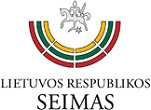Seimas in the Republic of Lithuania of 1920–1940
|
A card. Oaks of freedom (fenced) planted on 15 May 1920 to mark the convocation of the Constituent Seimas. Publisher of the album of cards: Petras Ruseckas, Member of the Constituent Seimas. Kaunas. Around 1922. |
Even before the declaration of independence, Lithuania was referred to as a parliamentary state. On 3 June 1917, a Lithuanian assembly in Petrograd adopted a resolution declaring that the mode of governance and internal order of the independent Lithuania would be determined by the Constituent Assembly of Lithuania elected by universal and equal suffrage and by secret ballot. On 21 September 1917, the Vilnius Conference decided that the final foundations for an independent state of Lithuania would be laid by the Constituent Seimas in Vilnius. The urgency to convene the Constituent Seimas was repeatedly referred to in the Act of Independence of Lithuania of 16 February 1918. Constituent assemblies had been convoked in all the countries established after World War I. Accordingly, they convened in Poland in February 1919, in Estonia in April 1919, and in Latvia on 1 May 1920. On 15 May 1920, the Constituent Seimas convened in Lithuania. The convocation of the Lithuanian Constituent Seimas was delayed by external factors, namely, fights against the Red Army and the Bermontians and the complicated situation related to the occupation by Poles of eastern Lithuania with the capital Vilnius. Until July 1919, Lithuania’s sovereignty was restricted by the German administration, which was in control of transport (railways) and communications (the post and the telegraph).
In the period from 1918 to 1940, five parliaments in total had been convened in Lithuania. As many as three of them were dissolved by decree of the President of the Republic and did not serve their entire tenures. Only two parliaments, namely the Constituent Seimas and the Second Seimas, served their full legislative terms. The period of parliamentary democracy in the Lithuania of the time lasted slightly more than six and a half years (from 15 May 1920 to 12 April 1927). The abundance of political parties, poor political culture, and inability to reach an agreement had been compromising the idea of democracy. The balance of powers was disturbed by the coup of 17 December 1926 and lost altogether on 12 April 1927 with the failure to call new elections following the dissolution of the Third Seimas. Those were the years of collapse of democracy, marking the beginning of the presidential rule when Lithuania was governed through presidential decrees. Even though the Fourth Seimas had been convened in 1930s (1936–1940), it was still far removed from an actual democratic parliament and was more likely to merely resemble parliamentarianism, because the main leverages of power remained in the hands of the President of the Republic.
Every Lithuanian parliament acted in accordance with the Statute of the Seimas. A total of three Statutes of the Seimas had been adopted, namely, the 1921 Statute of the Constituent Seimas and the 1924 and the 1936 Statutes of the Seimas. Members of the Seimas had the right of legislative initiative (a legislative proposal could be submitted by no less than eight parliamentarians), the right to submit an interpellation against the Cabinet of Ministers, and the right of enquiry. Members of the Constituent Seimas enjoyed immunity from legal proceedings and, thus, could not be arrested, searched, or subjected to correspondence control without prior approval by the Seimas. The 1922 Constitution enshrined that a legislative term of the Seimas lasted three years. Meanwhile, the 1928 Constitution provided for a five-year-long period. The same legislative period was also stipulated in the 1938 Constitution.
Every parliament sat in the Lithuanian provisional capital city of Kaunas. The opening sitting of the Constituent Seimas was held in Kaunas City Theatre (currently Kaunas State Musical Theatre) on 15 May 1920. Other sittings were held in the building of the Seimas (currently Maironis University Gymnasium in Kaunas). The same premises had been used by the First, Second, and Third Seimas. The building of the Seimas also saw the reading of the act of 12 April 1927 on dissolution of the Seimas. The Fourth Seimas held its sittings in the building of the Ministry of Justice (currently Kaunas State Philharmonic Society), which housed the Ministry of Justice and the Supreme Tribunal.
Certain traditions had been shaped in the period of parliamentarianism. The President would convene the first sitting of the newly elected Seimas. Elected Members of the Seimas, Government representatives, the diplomatic corps and society would be invited for a holly mass before convening the first sitting of the Seimas. The opening sitting would be chaired by the oldest Member of the Seimas while the youngest Member of the Seimas would be appointed as Secretary of the sitting (only the Fourth Seimas failed to follow in the tradition). During the first sitting of the Seimas, the elected parliamentarians would take the oath of office or loyalty, thereby becoming full-fledged Members of the Seimas (only Members of the Constituent Seimas had apparently escaped this obligation).
References:
Truska Liudas, Steigiamasis Seimas (1920–1922), Lietuvos Seimo istorija. XX–XXI a. pradžia, Vilnius: Baltos lankos, 2009.
Prepared by Vilma Akmenytė-Ruzgienė


 Scheduled broadcasts
Scheduled broadcasts







